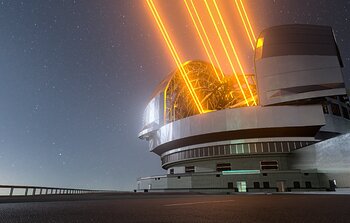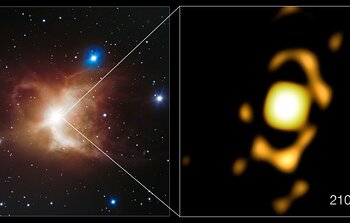| | Galaxies begin to "die" when they stop forming stars, but until now astronomers had never clearly glimpsed the start of this process in a far-away galaxy. Using the Atacama Large Millimeter/submillimeter Array (ALMA), in which the European Southern Observatory (ESO) is a partner, astronomers have seen a galaxy ejecting nearly half of its star-forming gas. This ejection is happening at a startling rate, equivalent to 10 000 Suns-worth of gas a year — the galaxy is rapidly losing its fuel to make new stars. The team believes that this spectacular event was triggered by a collision with another galaxy, which could lead astronomers to rethink how galaxies stop bringing new stars to life. The release, images and videos are available on:
https://www.eso.org/public/news/eso2101/ Kind regards,
The ESO Department of Communication
11 January 2021
 | 16 December 2020: On Friday 11 December, ESO Director General Xavier Barcons received the Order of Bernardo O'Higgins Grand Cross, at a ceremony chaired by Carolina Valdivia, the Chilean Undersecretary of Foreign ... | | Read more |  | 4 December 2020: The Extremely Large Telescope (ELT), ESO's new flagship telescope being built to answer the biggest questions about our Universe, has received a 10% increase to its budget. The funding ... | | Read more |  | 3 December 2020: To strengthen its cooperation with Chile, ESO provides and manages an annual fund that awards projects dedicated to the development of science research, technology and education in astronomy. The Joint ... | | Read more |  | 24 November 2020: M1, the main mirror of ESO's Extremely Large Telescope (ELT), is moving closer to completion with the approval of the final design for its edge sensors, with its positions ... | | Read more |  | 19 November 2020: While the construction of ESO's Extremely Large Telescope (ELT) in Chile's Atacama Desert is on hold due to the COVID-19 pandemic, important progress on the project is being ... | | Read more |  | 17 November 2020: A newly and better processed version of data on planet Venus, collected with the Atacama Large Millimeter/submillimeter Array (ALMA) in Chile, has now been made publicly available via the ... | | Read more |  | 6 November 2020: A major component of ESO's Extremely Large Telescope (ELT), its first prefocal station or PFS-A, is now close to completing its final design review. With this milestone nearly reached ... | | Read more |
 | 1 January 2021: From watching a star dance around a supermassive black hole to imaging multiple planets around a Sun-like star, 2020 has seen some amazing astronomical discoveries. In this blog post, we ... | | Read more |  | Interview with Dinko Milaković 11 December 2020: One of the biggest mysteries in astronomy is understanding the laws that govern our Universe. Dinko Milaković has been part of a team of astronomers using ESO's 3.6-metre telescope at ... | | Read more |  | Anna Purdue 27 November 2020: A team of astronomers led by Keiichi Ohnaka in Chile have looked deep into the core of the Toby Jug Nebula to gather clues on how dying stars change into ... | | Read more |  | Stephanie Rowlands 6 November 2020: ESO's many telescopes at La Silla and Paranal Observatories in Chile gaze up at thousands of astronomical objects every year. Before astronomers catalogued these objects with names such as NGC ... | | Read more | | | | | | | |
|